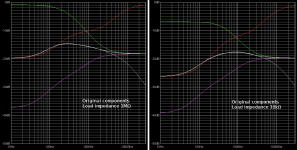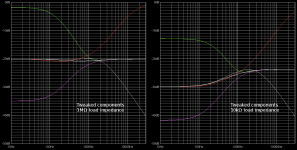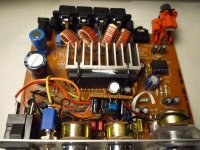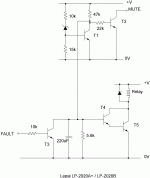Interesting thread that I will be following.
I just odered one a few days ago from Parts Express and it wiil be intertesting to hear how it sounds.
I'm just going to start off usiing a a pair of Tang Band "W3-881SJ" 3" drivers.
It's only for TV sound.
I will also try connecting a "Sony XDRF1DHD" radio tuner to it.
I just odered one a few days ago from Parts Express and it wiil be intertesting to hear how it sounds.
I'm just going to start off usiing a a pair of Tang Band "W3-881SJ" 3" drivers.
It's only for TV sound.
I will also try connecting a "Sony XDRF1DHD" radio tuner to it.
Bass is back and pops are gone!
Has anyone analyzed the circuit on the newer models, especially the one with the two op-amps? I don't have one, but my guess is that the second op-amp sits between the output of the tone stack and the TA2020's inputs. There is a very good reason why they did this, and in fact you should either add this second op-amp if you still have a Lepai with one op-amp, or bypass the tone controls. I'll explain why.
The 'James' tone stack used in the Lepai only works well if it is connected to a load of fairly high impedance. But it seems that the input impedance of the Tripath chip is pretty low. I can't find any values in the datasheet but some sources say it's about 10kΩ. This is plausible, some other class D chips also have similar impedances when set to a high gain.
Attached are some images that show how the tone curves differ between a high load impedance (1MΩ) and low (10kΩ), both for the original James component values that were installed on my Lepai and the ones I replaced them with while I still thought the TA2020 had a high input impedance. As you can see, especially in the latter case there is considerable loss of bass and overall signal strength.
It may be possible to find component values for the resistors and caps in the tone circuit that produce good curves even with the low input impedance. But the capacitor values will probably be impractically high and even then the curves would still change with variations of the TDA2020's impedance. The only correct solution is to buffer the tone stack's output, and this is also what I did. If you look at the photo, you'll see a little ugly dangling board which is a simple op-amp buffer. The result is impressive: I forgot how much bass I missed in certain songs . And that's not all: the power-on pop is almost completely gone, even when starting the amp non-muted.
. And that's not all: the power-on pop is almost completely gone, even when starting the amp non-muted.
The bottom line is: if you still have a Lepai with only one op-amp and don't care about the tone controls, then by all means bypass them. If you want them, adding a buffer amplifier is a must, as is replacing the components.
Has anyone analyzed the circuit on the newer models, especially the one with the two op-amps? I don't have one, but my guess is that the second op-amp sits between the output of the tone stack and the TA2020's inputs. There is a very good reason why they did this, and in fact you should either add this second op-amp if you still have a Lepai with one op-amp, or bypass the tone controls. I'll explain why.
The 'James' tone stack used in the Lepai only works well if it is connected to a load of fairly high impedance. But it seems that the input impedance of the Tripath chip is pretty low. I can't find any values in the datasheet but some sources say it's about 10kΩ. This is plausible, some other class D chips also have similar impedances when set to a high gain.
Attached are some images that show how the tone curves differ between a high load impedance (1MΩ) and low (10kΩ), both for the original James component values that were installed on my Lepai and the ones I replaced them with while I still thought the TA2020 had a high input impedance. As you can see, especially in the latter case there is considerable loss of bass and overall signal strength.
It may be possible to find component values for the resistors and caps in the tone circuit that produce good curves even with the low input impedance. But the capacitor values will probably be impractically high and even then the curves would still change with variations of the TDA2020's impedance. The only correct solution is to buffer the tone stack's output, and this is also what I did. If you look at the photo, you'll see a little ugly dangling board which is a simple op-amp buffer. The result is impressive: I forgot how much bass I missed in certain songs
The bottom line is: if you still have a Lepai with only one op-amp and don't care about the tone controls, then by all means bypass them. If you want them, adding a buffer amplifier is a must, as is replacing the components.
Attachments
I just got my LP-2020A+ a few days ago.
My first impressions from a purely listening standpoint are........
1) It is ony 20wc or about 12wc @8oms so, yeah, you can't expect too much volume out of it before different forms of distortion get too high.
2) The tone controls, are about worthless but, I guess they're better than nothing
I'm going to run it with the tone bypassed and the input run through a vintage Technics stereo 7 band EQ that I had on hand..... recently purchased on e-bay for $10.
I'm also going to run it through the high-pass of a powered sub to power the L/R mains.
So, I discovered so far that a bit of proper freq EQ can work wonders (of course) and the amp sounded fairly decent (with my test speakers) for what it is: a small, inexpensive, low powered amp.
I assume that adding the sub will only improve the sound by taking the low freq load off it.
For me, it's just a fun, inexpensive little amp, although it does look a bit lost sitting on top of the large, vintage EQ.
My first impressions from a purely listening standpoint are........
1) It is ony 20wc or about 12wc @8oms so, yeah, you can't expect too much volume out of it before different forms of distortion get too high.
2) The tone controls, are about worthless but, I guess they're better than nothing
I'm going to run it with the tone bypassed and the input run through a vintage Technics stereo 7 band EQ that I had on hand..... recently purchased on e-bay for $10.
I'm also going to run it through the high-pass of a powered sub to power the L/R mains.
So, I discovered so far that a bit of proper freq EQ can work wonders (of course) and the amp sounded fairly decent (with my test speakers) for what it is: a small, inexpensive, low powered amp.
I assume that adding the sub will only improve the sound by taking the low freq load off it.
For me, it's just a fun, inexpensive little amp, although it does look a bit lost sitting on top of the large, vintage EQ.
Last edited:
candoumi:
The op-amps are the cheapo 4558s. Boo Hiss! I'm in the process of putting in LM4562s. Fortunately I have a technician friend who can do surface mount soldering. That's the one drawback of having a much better board.
I've taken a quick look at the PCB and I don't think the tone defeat bypasses the op-amps.
My two cents,
Ed Perkins
The op-amps are the cheapo 4558s. Boo Hiss! I'm in the process of putting in LM4562s. Fortunately I have a technician friend who can do surface mount soldering. That's the one drawback of having a much better board.
I've taken a quick look at the PCB and I don't think the tone defeat bypasses the op-amps.
My two cents,
Ed Perkins
I got the Lepai a few days ago to connect some bookshelves to my PC. There's a buzz if I turn up the volume past the 11-o'clock position. I can turn the volume higher if I use my iPod touch, but that depends where I put the touch. I'm new to home audio, so I'm guessing this is a grounding problem. What's the cheapest way to fix this without interfering with audio quality?
A bit over a week ago I received a Topping TP30 amp to replace this dissappointing Lepai one - I was meant to get the Topping to begin with, but skimped in the end... bad move! Sure the Topping costs 3,5 times as much, but it's "infinitely" better as well and still cheap! I honestly can't say why the Lepai seems reasonably liked, when to me it just sounds crappy. And I'm by no means overly demanding! This TP30 for example is simply awesome, I've zero bad things to say about it whether I'm driving my 250€ or my 5900€ speakers (not that I paid more than half price for the latter, nor do I normally drive those with the TP30). But the Lepai... thin, more or less harsh sound with any speakers (didn't try with the best ones, would be pointless), and of course the finish is what it is - but it wouldn't matter especially given the price if only the sound was acceptable, which it's not.
Voltage regulator
I got a Lepai a few weeks ago, it seems to be somewhere between the 2011 version and the old one - it has the output relay, but the rest of the board is the same as the older ones...
I run mine off a 12V lead acid charged by solar panel. I use a LT1764a regulator to keep the voltage at 12.2V (says 12V, 2A on the Lepai jack) and I've had no problems so far - sounds very good and I'm pleased with it. I'm thinking of ordering another one to play with...
If anyones interested in the regulator, its an adjustable low drop out type, 3A output & very simple circuit: it would easily fit inside the Lepai box, although I opted for an external box. See http://cds.linear.com/docs/Datasheet/1764afb.pdf for the datasheet & circuit diagrams.
I got a Lepai a few weeks ago, it seems to be somewhere between the 2011 version and the old one - it has the output relay, but the rest of the board is the same as the older ones...
I run mine off a 12V lead acid charged by solar panel. I use a LT1764a regulator to keep the voltage at 12.2V (says 12V, 2A on the Lepai jack) and I've had no problems so far - sounds very good and I'm pleased with it. I'm thinking of ordering another one to play with...
If anyones interested in the regulator, its an adjustable low drop out type, 3A output & very simple circuit: it would easily fit inside the Lepai box, although I opted for an external box. See http://cds.linear.com/docs/Datasheet/1764afb.pdf for the datasheet & circuit diagrams.
Ed Perkins, thank you. I'll buy one to test it.candoumi:
The op-amps are the cheapo 4558s. Boo Hiss! I'm in the process of putting in LM4562s. Fortunately I have a technician friend who can do surface mount soldering. That's the one drawback of having a much better board.
I've taken a quick look at the PCB and I don't think the tone defeat bypasses the op-amps.
My two cents,
Ed Perkins
Just got my two LP-2020-A+ from Parts Express. First I want to thank everyone who contributed to this thread! Because of you knowledgeable folks I decided that the Lepai was going to be acceptable out of the box and could potentially be much better with a little tweaking.
Inside they look like the image candoumi posted on this page which means some of the mods posted about earlier models aren't applicable. I'm wondering if anyone has a comprehensive list of things to do the the newest model, possibly in order of greatest improvement on down. ernperkins mentioned swapping the op-amps from 4558s to LM4562s but alas, I don't have any friends with SMD capabilities. I am also wondering if anyone has done a good test of the A+ model to determine what actually needs to be replaced after all of Lepai's changes to it.
[* I just had a closer look at candoumi's photo and it looks like the op-amps are marked JRC 456something.]
I tested the amps side-by-side with my set-up which is Apple Airport Express --> Lepai --> Bose 161 speakers. I'm using one rig in a small bedroom and one in the bathroom and with Air Play we can play music wirelessly from an iPhone or any computer running iTunes. [I'm no Apple fanboy but I can't recommend the Airport Express enough. Having easy wireless audio totally changed the way I listen. I listen much more now and to a wider range of stuff.] When I switched from one amp to the next I was shocked at the HUGE difference in loudness from the amps. The loud one with volume knob set at 9 o'clock is as loud as the other set at 12 o'clock. Everything else seems ok though, but I'm going to return one once I can figure out which is out of whack. The loud one seems punchier too, but almost too loud for it's own good...
As it stands I'm pretty happy with the units. They're nice and small, and sound good enough for $20. I'm still interested in improving them though because I can tell that ear fatigue could be an issue. They're not primary listening rigs though so it may not be important. I am also thinking about some kind of audio-sensing switch in the bathroom unit because it'll be buried in a closet.
I'm somewhat capable when it comes to electronics stuff but far from comfortable so if I had gotten the old model the contributions from the posters would have made my day. Thanks again for your help and sharing your knowledge!
Inside they look like the image candoumi posted on this page which means some of the mods posted about earlier models aren't applicable. I'm wondering if anyone has a comprehensive list of things to do the the newest model, possibly in order of greatest improvement on down. ernperkins mentioned swapping the op-amps from 4558s to LM4562s but alas, I don't have any friends with SMD capabilities. I am also wondering if anyone has done a good test of the A+ model to determine what actually needs to be replaced after all of Lepai's changes to it.
[* I just had a closer look at candoumi's photo and it looks like the op-amps are marked JRC 456something.]
I tested the amps side-by-side with my set-up which is Apple Airport Express --> Lepai --> Bose 161 speakers. I'm using one rig in a small bedroom and one in the bathroom and with Air Play we can play music wirelessly from an iPhone or any computer running iTunes. [I'm no Apple fanboy but I can't recommend the Airport Express enough. Having easy wireless audio totally changed the way I listen. I listen much more now and to a wider range of stuff.] When I switched from one amp to the next I was shocked at the HUGE difference in loudness from the amps. The loud one with volume knob set at 9 o'clock is as loud as the other set at 12 o'clock. Everything else seems ok though, but I'm going to return one once I can figure out which is out of whack. The loud one seems punchier too, but almost too loud for it's own good...
As it stands I'm pretty happy with the units. They're nice and small, and sound good enough for $20. I'm still interested in improving them though because I can tell that ear fatigue could be an issue. They're not primary listening rigs though so it may not be important. I am also thinking about some kind of audio-sensing switch in the bathroom unit because it'll be buried in a closet.
I'm somewhat capable when it comes to electronics stuff but far from comfortable so if I had gotten the old model the contributions from the posters would have made my day. Thanks again for your help and sharing your knowledge!
Last edited:
LP-2020B
I got another one off ebay arrived a few days ago. Its an LP-2020A+ on the case, but the board inside is LP-2020B... It has the 'protection relay', surface mount components but only one op-amp. I mapped out the relay protect circuit, but I'm not convinced by it... Its still connected to the fault pin and looks like it will toggle the relay off if this goes high, but it is also connected to the mute/over voltage circuit. This will perform an automatic reset of the fault condition (see datasheet), which I don't think is desireable. Another thing - the relay only switches one side of each differential output - so for example, a short could occur on either pin and will not necessarily be disconnected by the relay. I'm not sure why this relay protect is necessary other than to prevent the switch on pop - but then why connect to the fault pin? From the tripath data sheet:
"The TA2020-020 is guarded against over-temperature and over-current conditions. When the device goes into an over-temperature or over-current state, the FAULT pin goes to a logic HIGH state indicating a fault condition. When this occurs, the amplifier is muted, all outputs are TRI-STATED, and will float to 1/2 of VDD."
What do other people think of this 'relay protect'? If I get time I'll draw up the schematic I have and post.
I've made the following mods to the new one:
1. Removed overvoltage circuit and relay circuit - tied mute to gound and added an LED to the fault pin.
2. Removed tone control/volume control and op-amp
4. Replace input caps with 2.2 uF (they were 1.75uF)
I'm very pleased with the result - it does sound much better without the tone controls as an earlier post suggested - better bass response, and I think the treble sounds sharper too. Using a 12V regulated power supply I don't need the protection circuit, or the extra diode on the output (data sheet says they are only needed for voltages >13.5V). The switch on 'thump' is minimal once the op-amp/tone control is removed, as an earlier post suggested.
I got another one off ebay arrived a few days ago. Its an LP-2020A+ on the case, but the board inside is LP-2020B... It has the 'protection relay', surface mount components but only one op-amp. I mapped out the relay protect circuit, but I'm not convinced by it... Its still connected to the fault pin and looks like it will toggle the relay off if this goes high, but it is also connected to the mute/over voltage circuit. This will perform an automatic reset of the fault condition (see datasheet), which I don't think is desireable. Another thing - the relay only switches one side of each differential output - so for example, a short could occur on either pin and will not necessarily be disconnected by the relay. I'm not sure why this relay protect is necessary other than to prevent the switch on pop - but then why connect to the fault pin? From the tripath data sheet:
"The TA2020-020 is guarded against over-temperature and over-current conditions. When the device goes into an over-temperature or over-current state, the FAULT pin goes to a logic HIGH state indicating a fault condition. When this occurs, the amplifier is muted, all outputs are TRI-STATED, and will float to 1/2 of VDD."
What do other people think of this 'relay protect'? If I get time I'll draw up the schematic I have and post.
I've made the following mods to the new one:
1. Removed overvoltage circuit and relay circuit - tied mute to gound and added an LED to the fault pin.
2. Removed tone control/volume control and op-amp
4. Replace input caps with 2.2 uF (they were 1.75uF)
I'm very pleased with the result - it does sound much better without the tone controls as an earlier post suggested - better bass response, and I think the treble sounds sharper too. Using a 12V regulated power supply I don't need the protection circuit, or the extra diode on the output (data sheet says they are only needed for voltages >13.5V). The switch on 'thump' is minimal once the op-amp/tone control is removed, as an earlier post suggested.
Lepai 2020B relay protect circuit
OK, here is the relay protect circuit as best as I can trace it. It is all surface mount. The thing that concerns me is the connection between the fault/relay circuit and the overvoltage/mute circuit. In the case of Fault going high, I think this would 'toggle' the mute pin which resets the fault. But if the fault condition persists, will this lead to damage to the TA2020?
OK, here is the relay protect circuit as best as I can trace it. It is all surface mount. The thing that concerns me is the connection between the fault/relay circuit and the overvoltage/mute circuit. In the case of Fault going high, I think this would 'toggle' the mute pin which resets the fault. But if the fault condition persists, will this lead to damage to the TA2020?
Attachments
Hi guys. I hope you can help me. I'm afraid I'm not technically minded.
I've just purchased a Lepai Tripath TA2020 and have connected a pair of old Sony speakers to it.
The thing is when I switch the little amp on a loud pop comes from the speakers and they physically pop out. Can I ask the following questions:
a) Is this doing any harm to my speakers ?
b) Is it because the speakers aren't rated high enough to receive the amp's output or do you think there is a fault with the amp ?
c) Will getting a higher rated pair of speakers cure this ?
d) Can I stop it without getting a new pair of speakers
Thanks for any help you might be able to offer.
I've just purchased a Lepai Tripath TA2020 and have connected a pair of old Sony speakers to it.
The thing is when I switch the little amp on a loud pop comes from the speakers and they physically pop out. Can I ask the following questions:
a) Is this doing any harm to my speakers ?
b) Is it because the speakers aren't rated high enough to receive the amp's output or do you think there is a fault with the amp ?
c) Will getting a higher rated pair of speakers cure this ?
d) Can I stop it without getting a new pair of speakers
Thanks for any help you might be able to offer.
- Status
- This old topic is closed. If you want to reopen this topic, contact a moderator using the "Report Post" button.
- Home
- Amplifiers
- Class D
- Lepai T-Amp with TA2020




